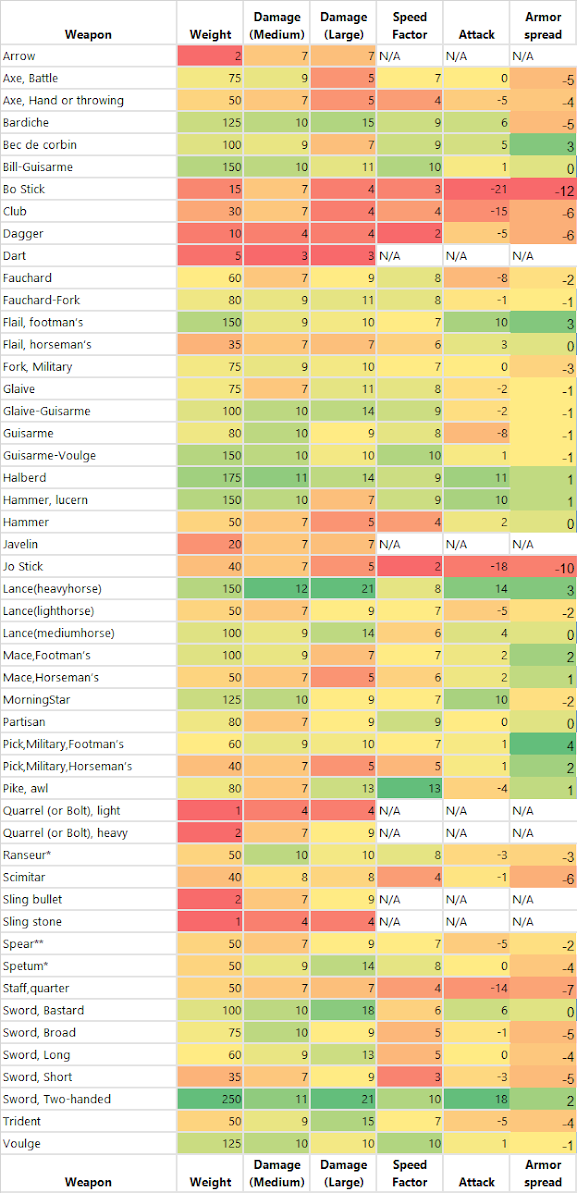In a recent post, I mentioned that I find the procedure for random encounters too lengthy - it can require half a dozen rolls or more to go from "is there an encounter?" to "you see 20 surprised, hostile bandits".
There are some simple ways to shorten this procedure significantly - mostly by reducing encounter checks to ONE per encounter (instead of two to six) and folding distance, surprise and initiative into a single roll.
There are some simple ways to shorten this procedure significantly - mostly by reducing encounter checks to ONE per encounter (instead of two to six) and folding distance, surprise and initiative into a single roll.
Random encounter check
The chances of random encounters vary according to terrain: usually, 1-in-6 for in grasslands (clear, plains), 2-in-6 in barren lands, hills, deserts, woods, oceans and rivers, and 3-in-6 in mountains, jungles, and swamps. This means you have an average of one encounter per six, three or two days of travels, respectively.
If you want to avoid rolling six times to get an encounter in the grasslands, for example, you can invert the rationale: roll 1d12 to see how many days the PCs will travel before the next encounter (a one means an encounter in the first day of travel, etc.). Use 1d6 for forests and hills, 1d4 for jungles, and so on.
Adjust the numbers to taste – for example, if you want to make encounters more often count 8-hour periods instead of days. Alternatively, if you think deserts should be a little less crowded, use 1d10 or 1d12 instead of 1d6.
I think B/X encounter tables are bonkers, but to save some time, you could reduce the process of "1d8 table and 1d12 sub-table" to a single d100 roll. It makes little difference, but you could use the opportunity to "fix" the tables to your liking - giving forests more green dragons and fewer red dragons, for example.
Number appearing
Number appearing
Not much to say or fix here (excepted as noted under surprise and initiative, below), but let me know if you have any ideas!
I've toyed with a couple of ideas, but I ended up simplifying things: 1/3 of NA in "civilized" regions and 1/2 in the "borderlands".
Surprise and initiative
Surprise and initiative
These rolls are connected. You usually only for initiative if you are not surprised. I find this redundant; you can just roll 1d6 for each side to decide both surprise and initiative (with one caveat: if only one side is surprised, it cannot take action in the first round).
If you want to make surprise/initiative more detailed, you could assign a bonus (+1 to +3) to the smaller side, if there is a significant difference. A group of five PCs is very likely to hear 40 brigands approaching – or maybe even a big creature (such as a hydra) in a forest. Alternatively, you can describe someone surprised by a dragon or army as temporarily paralyzed by fear!
One important thing to remember is that rolling for initiative does not mean starting a combat. The side that gains initiative has a good opportunity of running away or making a sign of good will before the other side can act.
Distance
Encounter distance in the wilderness is 4d6 × 10 yards (or 1d4 × 10 yards if either side is surprised). This post suggests that the surprise/initiative roll could replace this - a very elegant solution!
For example, you could add the rolls from both sides and multiply it by 10 yards in dungeon, or multiply the three numbers in wilderness.
I might use 20-40 yards in open plains, deserts, etc., IF there is nowhere to hide.
Reaction
To be honest, I simply do not want to simplify the reaction roll. On the contrary, I like the social mini-game it can create.
One thing to consider is maybe only rolling in the creature's initiative, so that PCs do not know how they'll act beforehand (and the PC's actions may affect the roll). Another idea is giving chaotic monsters a reaction penalty, and lawful ones a bonus.
A book of encounters?
I'm working on a PDF about B/X encounters, to be released in May! It includes these ideas and much more.
It reduces encounters to a single d100 roll, each giving a result such as:
24 Berserker 11:00 130/20 No (5) 12 (F) Gromm’s clan is extremely hospitable.
Stay tuned or follow me on social media if you're interested.
Affiliate links - by using this, you're helping to support this blog!














.jpg)

